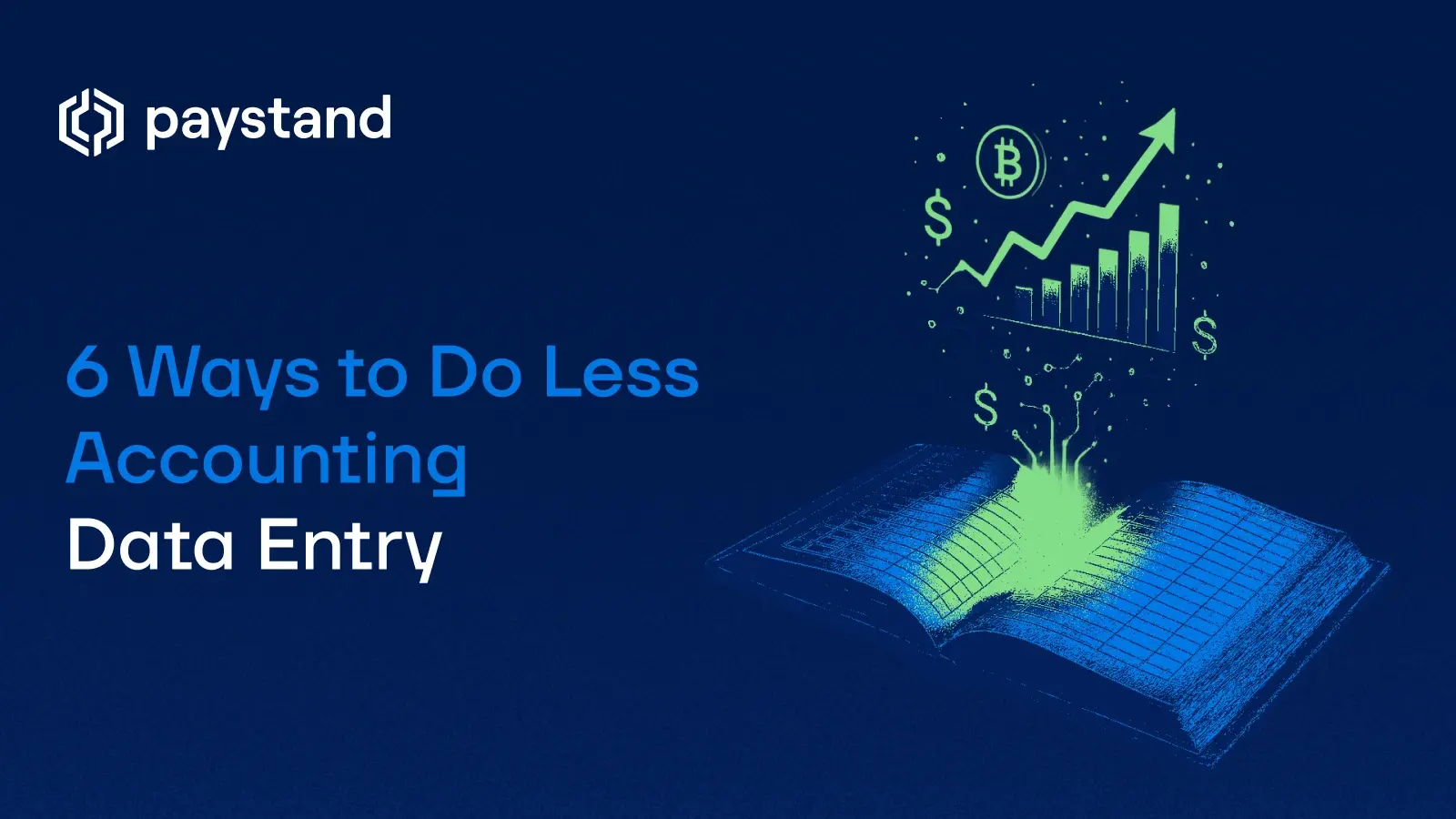6 Ways to Do Less Accounting Data Entry

- What is Data Entry in Accounting?
- Why Accurate Data Entry Matters in Businesses?
- Key Skills for Effective Data Entry
- Manual vs. Automated Data Entry
- 6 Ways to Create a Painless Data Entry Process
- Empower Your Team
.Key takeaways
- Maintaining the integrity of your accounting ledger is critical to business success—but manual processes just aren’t cutting it anymore.
- Automated data entry can cut costs, save time, and boost accuracy.
- There are many ways to leverage an automated accounting data entry process to reduce errors, lower costs, and strengthen the finance team.
What Is Data Entry in Accounting?
Data entry in accounting refers to the process of recording financial transactions into an accounting system—typically involving invoices, receipts, and expense data. In the past, it was a paper-and-pencil process, but now most accountants work with digital software and ERPs. There are many forms of data entry—for accounts payable, it’s common in invoice processing, reconciliating receipts and payments, managing approvals, and issuing reimbursements.
Without it, it’s impossible to have a transparent look into the financial health of an organization. Poor data entry practices also open the door to human error and fraud risk, which can significantly impact the company.
Why Accurate Data Entry Matters for Businesses
.Data entry isn’t just tedious; it’s also prone to errors, and those errors can end up costing your company a fortune. Consider the 2017 crash of Amazon AWS, which was caused by a data-entry error by a debugging programmer and resulted in a $150 million loss for S&P 500 companies alone (and likely even more for the countless smaller companies that used the service). While that may be an extreme case, it’s a grim example of how a single, basic user error can wreak havoc on a wide scale.
The finance industry has been quick to embrace automation as a way to reduce the relatively large number of data-entry processes in accounting. AccountingWeb reports that in the next few years, roughly 40% of common accounting and finance tasks will be performed by Artificial Intelligence (AI). But there’s no need to wait any longer to incorporate automation into your daily grind; hundreds of accounting programs, bots, and plugins are already here and eager to help. Here are some of the most common accounting-related data entry tasks and the tools you can use to get rid of them for good.
Key Skills for Effective Data Entry
Data entry is often boring and time-consuming, but it requires a number of critical skills. Knowledge of accounting is the foundation, but most AP professionals also benefited from skills like:
- Fast typing
- Time, project, and financial management
- Attention to detail
- Analytical skills, especially regarding financial data and payment trends.
- Data management knowledge
- Compiling and formatting data, report generation
- Communication and relationship building with vendors, clients, and other departments
Many of these skills remain important to AP professionals today, despite the rise in automation. That’s because while these skills lend themselves to automation, they are also used for wider purposes.
Manual vs. Automated Data Entry
The main difference between manual and automated data entry is simple. One uses humans, the other, machines. Automation does not automatically translate into AI-powered software, but it is often a component.
The main issue with manual data entry is that it takes too long and is prone to errors. Automation all but eliminates these problems and saves accounting professionals time to do more high-value tasks.
For example, according to Ardent’s State of ePayables 2025 report, finance teams using top automation solutions see 79% lower costs than their peers while processing invoices 79% faster. Furthermore, they have 1.8x more invoices running straight through the automation. This translates into fewer exceptions and even more time saved.
But automation does not replace the accountant—and this is important to members. It is a tool meant to empower finance teams. Accelerating the accounting data entry process without sacrificing security or accuracy enables teams to identify further savings and growth opportunities.
The Role of Automation in Data Entry
Until the last decade, most of these tasks have been manual, causing a cascade of problems and late payments. When labor shortages hit during the pandemic, most companies recognized that their AP process needed to change. Automation tools rapidly became the best way to optimize processes.
Automation streamlines repetitive accounting tasks, reduces human error, and enables teams to process data more quickly and accurately. Using technology like Robotic Process Automation (RPA), Optical Character Recognition (OCR), or Artificial Intelligence (AI), companies can use custom rule sets and process various kinds of financial data without adding to their workload. These technologies fulfill the manual data entry role, allowing the accounting team to focus on auditing the data, reviewing reports, and tweaking the automation process.
6 Ways to Create a Painless Accounting Data Entry Process
1. Generating invoices
Depending on the size of your business, you may send anywhere from one to thousands of invoices out every month. Having to manually enter any significant number of invoices is time-consuming, especially if you have a complex billing model. Luckily, you have several options for setting up recurring invoicing and generally simplifying your billing process.
2. Inventory management
Businesses that sell a physical product face the often-formidable task of correctly managing their inventory. They must have the right inventory, at the right price, purchased at the right cost, and stored when and where it’s needed. There’s a lot of crunching numbers involved in getting inventory management right, and a single data entry error could put you out of business. That makes automating inventory management a high priority for product-driven companies.
3. Processing expenses and reimbursement requests
If your employees have a lot of reimbursement requests, you’ve got a potential data entry nightmare on your hands. Not only do the employees have to do tons of data entry to get the receipts into the system and fill out your expense forms, but then someone on the finance team has to process all those reimbursement requests and get them paid.
4. Processing vendor bills
Taking care of the business’s bills is usually a two-step process. First, you have to get vendor bills into your general ledger system. And second, you have to issue payments in the correct amount by the time they’re due. Both steps involve a fair amount of data entry, and errors could damage relationships with your vendors or even cause a drop in your business’s credit rating.
5. Bank reconciliation
Getting transactions from bank accounts and credit cards into the general ledger system can be quite a task. For businesses with tons of small transactions, such as many e-commerce businesses, manual bank reconciliation simply isn’t an option.
Then again, given the kinds of disasters that could result from a bank reconciliation data entry error, businesses of all sizes and types would be wise to consider automating this process helps ensure your financial records are always up to date.
6. Preparing payroll
Payroll is one accounting task that you really don’t want to mess up. Setting aside the disaster that could result from either overpaying or underpaying employees, a data entry error in your payroll processing could result in making the wrong federal and state withholdings and tax payments. That could get your business into a remarkably large amount of trouble very quickly. Since the math can get quite complex, calculating all the various employee wages and withholding amounts may require some level of automation.
Automating data entry frees up valuable human resources for more complex tasks and significantly reduces the risk of user error. Once you incorporate automation solutions into your finance and accounting process, you’ll wonder how you ever managed without them.
Empower Your Team
Accounts payable automation is key to empowering teams, reducing the risk of error, saving time, and tapping into accurate data. With automation handling the basics, your team can focus more on strategic tasks like data analysis and forecasting. Paystand AP & Expense offers finance professionals a robust spend management solution that includes AI procurement, virtual credit cards, spend analytics, and, of course, accounting data entry automation.
Discover the Paystand AP & Expense difference in our AP Automation solution for high-growth teams.







